VILMAR NUMISMATICSllc SHOWCASE VI





Vilmar Numismatics LLC PO Box 60 Big Indian, NY 12410 vilmar@aol.com www.vilmarnumismatics.com SHOWCASE VI JUNE-July 2024 Featuring a selection of greek silver and an extensive run of byzantine gold coins
ORDERING INFORMATION AND TERMS OF SALE
Email: vilmar@aol.com
(See our website for complete terms of sale and bibliographical information regarding abbreviations used.)
Please place your orders by email and refer to the inventory number provided at the beginning of each listing. The coins also appear as individual records on our website. All coins are offered subject to prior sale and no order is valid until confirmed by us in writing and accompanied by a formal invoice.
OUR GUARANTEE
We unconditionally guarantee the authenticity of all our coins. A coin may be returned for any reason within 10 days, but we ask that you first contact us and ship the piece back fully insured. Upon receipt of the return and providing it is in the same condition as originally sent out, we will issue a refund, minus any shipping and credit card charges. This guarantee does not apply if coins are removed from encapsulation.
NGC ENCAPSULATED COINS
Most of our coins are sold encapsulated in NGC holders. Such coins have been evaluated, graded, and encapsulated by NGC Ancients. NGC Ancients does not encapsulate any coins that in their opinion are fakes, of uncertain authenticity or have been repaired. In some cases, we offer raw coins, and these may be encapsulated upon request.
PAYMENT TYPES
Title does not pass until payment is made in full. Payment must be received within 7 days of the sale date. In the United States payment may be made by bank wire, money order or personal check drawn on a US bank. CREDIT CARDS (VISA, MC, AMEX) are generally accepted but an additional 4% service charge will be added. Payments from overseas (all foreign countries including Canada) may be made by bank wire.
SALES TAX
Sales tax will apply to all merchandise delivered within New York State and other select states as required.
SHIPPING CHARGES FOR COINS
United States: $50 for FEDEX or EXPRESS MAIL (delivery in 1–2 days within the US). Foreign, including Canada: $100 via fully trackable Fed Ex or USPS Global Express Mail. It is the responsibility of the buyer to comply with all customs regulations and pay for all duties/taxes in their country.
ILLUSTRATIONS USED IN THIS CATALOGUE
Coins are illustrated 1:1 and in various enlargements. In certain cases, we have also included images of older catalogues or publications wherein the specific piece is documented.
CREDITS
We are grateful to Oliver Hoover for his assistance in cataloguing and providing the historical notes, and to Mary Lannin for her editorial help. Photography and catalogue layout are the work of Alex Marinescu of Marinescu Designs, LLC.
WE WILL BE ATTENDING THE FOLLOWING COIN SHOWS AND LOOK FORWARD TO SEEING YOU
Whitman Baltimore Summer Expo, June 13–15, 2024
Summer FUN Show 2024, Orlando, FL, July 11–13, 2024
ANA 2024 World’s Fair of Money, Rosemont, IL, August 6–10, 2024
Whitman Baltimore Winter Expo, November 14–16, 2024

4
A
GORGON HEAD 20 ASSES WITH A DISTINGUISHED PEDIGREE
TO THE REV. PERCY BARRON COLLECTION SOLD BY JACOB HIRSCH IN 1911








19660. ETRURIA. POPULONIA. Ca. 3rd century BC. Silver 20 Asses, 8.47 g, 20 mm.

Obv. Facing head of Metus (Medusa), X:X (the mark of value) below. Rev. Blank, as struck, circular blob at edge.
Published: Vilmar Numismatics FPL I, lot 1; Vecchi, Etruscan Coinage, Group XII, Series 47, 47.137 (O13/R17) = Vecchi, The Coinage of the Rasna, part II, 30.1 (this coin, weight listed as 8.57 g and illustrated in an old cast image).
Ex Roma Numismatics XXIII, 3/24/2022, lot 5 = Baldwin’s 99, 5/4/2016, 547 = Colin Renfrew Collection 38 [per Vecchi], with ticket stating the coin was purchased in Paris and sold by A. H. Baldwin & Sons on 12/23/1955 = Glendining, 12/3/1929, 676 [Nordheim & Anderson collections] = Adolph Cahn 80 (2/27/1933), 18 [Sir Arthur Evans, L.A. Lawrence and others] = Jacob Hirsch 30 (5/11/1911), 9 [Rev. Percy Barron collection].
NGC graded CHOICE VF, Strike 4/5, Surface 4/5, the Hirsch 1911 pedigree noted.
$ 4000
5
POPULONIA
GOING BACK


19389. BRUTTIUM. RHEGIUM. Late 5th–early 4th centuries BC.
Silver Litra, 0.69 g, 10 mm.

Obv. Lion scalp facing. Rev. PH, olive sprig. Herzfelder, Les monnaies d’argent de Rhegium, p. 61, J and plate XI, J (“litra”); HN Italy 2499.
Ex NAC 92, part 2, 5/24/2016, lot 1409 = Kunst und Münzen 28, 6/18/1992, lot 60.
NGC graded AU, Strike 5/5, Surface 3/5, “lt. scratches,” nicely centered and struck, with old cabinet patina and blue iridescent highlights. $ 1200




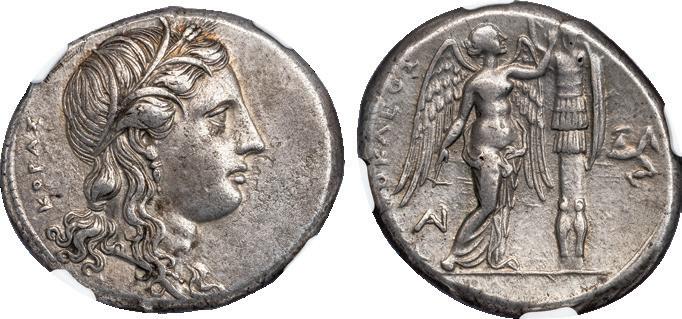
19619. SICILY. SYRACUSE. AGATHOCLES, 317–289 BC.
Silver Tetradrachm, 17.00 g, 26 mm. Issue of ca. 310–306 BC.

Obv. KOPAΣ, wreathed head of Kore right. Rev. A[ΓA]ΘOKΛEOΣ, Nike standing right, nailing armor to trophy, AI monogram beneath left wing, triskeles in right field.
Ierardi 100 (O21/R58); SNG Fitzwilliam 1349 (same dies); Dewing Collection 946 (same dies); HGC 1, 1536.
Ex Edward J. Waddell, inventory 56857 = Waddell Fixed Price List 66, 1995, lot 42.
NGC graded CHOICE XF, Strike 4/5, Surface 3/5, FINE STYLE. $ 6500
This beautiful tetradrachm of the Syracusan tyrant Agathocles is thought to have been struck to celebrate his major success against the Punic menace in Sicily that took place early in his rule. In 310 BC, Agathocles and a small force set out from Syracuse, which was closely besieged by the Carthaginians, and made his way to North Africa to take the fight to the Punic homeland. Once there he raised a great mercenary army and campaigned against the Carthaginians, forcing them to withdraw from Sicily. While the war in North Africa did not go nearly as well as the reverse of this coin might imply, and ultimately involved Agathocles secretly abandoning his army and returning to Syracuse in 307 BC, he had been the first Sicilian Greek ruler to take the war to Carthage, thereby saving Syracuse. The reverse type of Nike erecting a trophy was evidently popular and widely appreciated. A few years later it seems to have provided the model for a remarkable series of tetradrachms and fractions struck by Seleucus I Nicator at the distant mint of Susa.
6


18672. THRACIAN ISLANDS. THASOS. Ca. 150–140 BC.
Silver Tetradrachm, 16.88 g, 37 mm.
Obv. Wreathed head of young Dionysus right. Rev. ΗΡΑΚΛΕΟΥΣ

Heracles standing facing, head left, holding club, lion skin draped over left arm; ΔI monogram to inner left.
Prokopov, Silberprägung, Group I, 16–17 (V A4 / unlisted reverse die).
NGC graded CHOICE VF, Strike 5/5, Surface 3/5, “marks,” struck on a huge medallic planchet from dies of accomplished style; a rather rare variety for the voluminous Thasian series. $ 1350
A SEEMINGLY UNRECORDED ISSUE OF LYSIMACHEIA LACKING THE CITY’S SYMBOL


19161. KINGDOM OF THRACE. LYSIMACHUS, 305–281 BC.


Silver Tetradrachm, 17.08 g, 29 mm. Late lifetime–early posthumous issue of Lysimacheia, ca. 280–260 BC.
Obv. Head of deified Alexander the Great right, with the horn of Ammon. Rev. ΒΑΣΙΛΕΩΣ ΛΥΣΙΜΑXΟΥ, Athena enthroned left, holding Nike crowning Lysimachus’ name, ΦΛΤ control monogram in left field, ΣΘ (partially erased?) in exergue.
Cf. Schweizerischer Bankverein FPL Fall 1976, lot 28 (same obverse die, different reverse with ΦΛΤ in outer left field and a clear ΣΘ in exergue); Thompson 13 (Lysimacheia, same obverse die, ΦΛ and different control in exergue); Meydancikkale Hoard 2591 (Lysimacheia, same obverse, reverse with ΦΛ control and lion head in exergue); Roma Numismatics E–Sale 57, lot 344 (Lysimacheia, same obverse, reverse with ΦΛ control and lion head in outer left field).
Ex Private Collection, acquired from Baldwin’s on 5/19/1971.
NGC graded CHOICE XF, Strike 5/5, Surface 4/5, FINE STYLE, with a superbly rendered head of Alexander, an extremely rare variety with only the Schweizerischer Bankverein specimen cited above as a comparable (illustrated above). $ 3500
Although clearly linked in the minting sequence of Lysimacheia, this coin’s reverse apparently lacks the mint’s characteristic lion head symbol. The principal control is also slightly altered from the traditional ΦΛ into a somewhat different form incorporating the letter tau. The reason for avoiding Lysimacheia’s civic symbol on this issue remains unclear.
7
ΣΩΤΗΡΟΣ
ΘΑΣΙΩΝ,


19253. KINGDOM OF MACEDON. ALEXANDER III, THE GREAT, 336–323 BC.
Silver Tetradrachm, 17.06 g, 27 mm. Posthumous issue of Amphipolis, ca. 316–311 BC.

Obv. Head of young Heracles right in lion skin headdress. Rev. ΑΛΕΞΑΝΔΡΟΥ, Zeus enthroned left, holding eagle and scepter, shield in left field, ΠO below throne.
Price 136.
NGC graded XF, Strike 5/5, Surface 3/5, “graffito”.


18532. KINGDOM OF MACEDON. ALEXANDER III, THE GREAT, 336–323 BC.

Silver Tetradrachm, 17.16 g, 27 mm. Posthumous issue of Babylon, struck by Seleucus I ca. 317–311 BC.
$ 695
Obv. Head of young Heracles right in lion skin headdress. Rev. ΒΑΣΙΛΕΩΣ ΑΛΕΞΑΝΔΡΟΥ, Zeus enthroned left, holding eagle and scepter, MYTP monogram in wreath in left field, H below throne.
Price 3704; SC 82.6; Thompson, Armenak Hoard, 135.
Ex Salton Collection, likely acquired in the 1950s–1960s when Mr. Salton owned a numismatic firm in New York.
NGC graded VF, Strike 5/5, Surface 4/5, FINE STYLE, boldly struck with dark cabinet patina, the control monograms appear to have been recut over earlier ones, suggesting that the die was repurposed in the production line. $ 950


18508. MACEDONIA. ROMAN PROVINCE (FIRST MERIS). Ca. 167–148 BC.
Silver Tetradrachm, 16.67 g, 31 mm.

Obv. Draped bust of Artemis right, within decorated Macedonian shield. Rev. ΜΑΚΕΔΟΝΩΝ ΠΡΤΗΣ, club right, ΣΗΑTΡ monogram above, TKP and MYTE monograms below, all within wreath, thunderbolt in extreme left field.
HGC 3, 1103.
Ex Salton Collection, likely acquired in the 1950s–1960s when Mr. Salton owned a numismatic firm in New York.
NGC graded CHOICE FINE, Strike 4/5, Surface 2/5, “edge filing,” with attractive light gray cabinet patina. $ 750
8

19613. ATTICA. ATHENS. Ca. 440–404 BC.
Silver Tetradrachm, 17.21 g, 26 mm.


Obv. Helmeted head of Athena right. Rev. ΑΘΕ, owl standing right, head facing, olive sprig and crescent in left field, all within incuse square.
HGC 4, 1597; Kroll 8; SNG Copenhagen 31–40; Dewing 1591–1598.
NGC graded CHOICE AU, Strike 5/5, Surface 4/5.


17912. ATTICA. ATHENS. 2nd–1st CENTURY BC.
$ 1550

Silver New Style Tetradrachm, 28 mm. Issue of ca. 110/109 BC, struck under magistrates ΖΩΙΛΟΣ, ΕVANΔPOΣ and AΣKΛEΠI with control symbol bee.
Obv. Helmeted head of Athena Parthenos right. Rev. AӨE, owl standing right, head facing, magistrates’ names in fields, ZE on amphora, ΣO in exergue, all within olive wreath.
Thompson, New Style, 714h.
Ex Heritage 231927, 7/4/2019, lot 61046.
NGC graded VF. $ 1100
AEGINA STATER WITH AN UNUSUAL PROW COUNTERMARK



19528. ISLAND OF AEGINA. Ca. 525–480 BC.
Silver Stater, 12.28 g, 19 mm.

Obv. Sea turtle with shell showing a thick collar, its beaked head turned left [countermark with star flanked by crescents above ship’s prow (?) applied on shell]. Rev. Punch with skew pattern. Meadows, Group IIc; HGC 6, 433.
Ex Private Collection, Phoenix, AZ, acquired from Vilmar Numismatics LLC in March, 2023.
NGC graded CHOICE FINE, Strike 4/5, Surface 3/5, “countermark.” Countermarks applied to the turtle’s shell are a common feature on Aegina turtle staters. However, this countermark is particularly interesting in that it is figural, showing what appears to be a galley’s prow with a star flanked by crescents above. $ 1200
9



19562. BITHYNIAN KINGDOM. PRUSIAS I, ca. 230–180 BC.
Silver Tetradrachm, 16.91 g, 36 mm. Obv. Diademed head of Prusias right. Rev. ΒΑΣΙΛΕΩΣ ΠΡΟΥΣΙΟΥ, Zeus standing left, holding scepter and crowning royal name, thunderbolt above ME and ANΣ control monograms in left field. HGC 7, 614; Waddington 9b; Jameson 1387; SNG von Aulock 6878. NGC graded CHOICE VF, Strike 5/5, Surface 2/5, “brushed,” “light graffito,” struck on a very broad planchet, minor traces of encrustation. $ 1250
Prusias I was arguably one of the most powerful of the native kings of Bithynia. He expanded the kingdom to include territories in Bithynia and Mysia previously controlled by Byzantium and the Attalid kingdom, respectively. An alliance with Philip V of Macedon and territorial disputes meant that Prusias I was frequently at war with the Attalids for most of his reign. The Bithynian king infamously gave refuge to the great Hannibal and made use of a stratagem devised by the Carthaginian general involving the launching of baskets filled with poisonous snakes onto the decks of attacking Attalid war galleys during his war against Eumenes II in 187–183 BC. Prusias was ultimately defeated and forced to give up his claims to Attalid Phrygia and to surrender Hannibal to the Romans. During the conflict, however, he did gain the unfortunate nickname Cholos (“the Lame”) after he was injured by a stone thrown from the walls of Heraclea Pontica.



19545. IONIA. ISLAND OF CHIOS. Ca. 290–190 BC.
Silver Tetradrachm of Alexander type, 30 mm. Posthumous issue of Chios, ca. 202/1–190 BC. Obv. Head of young Heracles right in lion skin headdress. Rev. ΑΛΕΞΑΝΔΡΟΥ, Zeus enthroned left, holding eagle and scepter, ΠPYB monogram above sphinx seated right in left field.
Price 2396; Robert Bauslaugh, “The Posthumous Alexander Coinage of Chios,” Museum Notes 24, pp. 1 ff, Series 51 (B), obverse 58. NGC graded CHOICE VF. $ 675
10



19531. PAMPHYLIA. SIDE. 3rd–2nd centuries BC.
Silver Tetradrachm, 16.84 g, 29 mm.
Obv. Head of Athena right, wearing Corinthian helmet. Rev. Nike striding left, offering wreath, large pomegranate below arm, ΔEI–N. SNG Copenhagen 392; SNG France 3, 674–676.
Seyrig, Side, p. 63, Appendix, no. 7; SNG BN 677; SNG von Aulock 4787; CNG Triton XXVII, 1/17/2024, lot 5263 (same dies), realized $ 3250 hammer.
NGC graded CHOICE XF, Strike 5/5, Surface 4/5, dies of exceptional quality.



$ 2500
18882. CILICIA. TARSUS. Late 5th–4th centuries BC.
Silver Stater, 10.83 g, 21 mm.
Obv. Satrap riding horse right. Rev. Greek hoplite, nude but wearing helmet, kneeling left, raising shield with Gorgon emblem, and holding spear.
Casabonne Type F10.
NGC graded XF, Strike 3/5, Surface 2/5, “brushed.”
$ 975
This Tarsian stater represents the two critical elements in the administration of the Achaemenid Persian Empire. The mounted figure on the obverse represents the satrap (provincial governor), usually a Persian noble with connections to the royal family who was appointed by the Great King to govern a specific satrapy (province) of the empire. The will of the satrap, who served essentially as a viceroy with quasi–royal powers within his satrapy, was enforced by an army, which was commonly composed of hardened Greek mercenary hoplites, such as the warrior depicted on the reverse. Poverty in mainland Greece and the great upheavals caused by the Peloponnesian War (431–404 BC) caused many Greeks to take up their weapons and seek a better life by fighting for pay in the armies of the Great King’s satraps. This coin may very well represent money used to pay Greek mercenaries for their services to the Persian satrap of Cilicia using types depicting the paymaster on the obverse and the intended recipient on the reverse.
The early fourth century BC, when this coin was probably struck, was the dawn new age in which increasingly independent satraps began to use their Greek mercenary armies in conflicts with each other and to undermine the central authority of the Great King himself. This development is exemplified by the famous Ten Thousand Greek mercenaries who served under Cyrus the Younger in a failed attempt to dethrone Artaxerxes II in 401 BC and were forced to march back to their homes under the leadership of Xenophon. Interestingly, it was this civil war that saw the end of the subject dynasty of native Cilician kings at Tarsus and the creation of Cilicia as a Persian satrapy.
11
A TRIAD OF TOTEMIC LYCIAN BOARS FROM THE SAYAR COLLECTION PUBLISHED
BY MÜSELER
The boar, occasionally depicted with wings, was an important emblem used on the early silver coinages of the native dynasts of Lycia, perhaps as a symbol of the elite and quasi–royal status claimed by the issuers. Sculptural evidence like the Lycian sarcophagus from the royal necropolis of Sidon (c. 410–380 BC) suggests that Lycian dynasts engaged in boar hunts in imitation of the great royal lion hunts undertaken by Assyrian and Persian kings as a sign of their power over nature. The Lycians have simply substituted the dangerous wild boar, plentiful in their lands in antiquity, for the more customary lion as the royal quarry of choice.


19564. LYCIAN DYNASTS. UNCERTAIN, ca. 520–460 BC.
Silver Stater, 9.15 g, 17 mm.

Obv. Boar’s head right, randomly dotted neck collar. Rev. stellar pattern in incuse square.
Published: Wilhelm Müseler, Lykische Münzen in europäischen Privatsammlungen, no. I,8 (this coin listed and illustrated).
Ex Dr. Kaya Sayar Collection = NAC O, 5/13/2004, lot 1644.
NGC graded CHOICE VF, Strike 4/5, Surface 4/5, Müseler reference noted on label.


19565. LYCIAN DYNASTS. UNCERTAIN, ca. 520–460 BC.
Silver Stater, 8.20 g, 19 mm.
$ 2500

Obv. Protome of charging boar left, collar of single dots. Rev. elaborate incuse with X–shaped design.
Published: Wilhelm Müseler, Lykische Münzen in europäischen Privatsammlungen, no. II,2 (this coin listed and illustrated).
Ex Dr. Kaya Sayar collection = ex Amadeus collection, Gorny & Mosch 100, 11/18/1999, lot 184 = Monetarium SKA 39, 1983, lot 37 = Monetarium SKA 36, 1981, lot 63.
NGC graded CHOICE VF, Strike 4/5, Surface 4/5, Müseler reference noted on label.


19566. LYCIAN DYNASTS. UNCERTAIN, ca. 520–460 BC.
Silver Stater, 9.09 g, 19 mm.
$ 2750

Obv. Protome of charging boar right, solar (?) symbol on shoulder. Rev. Elaborate quadripartite incuse.
Published: Wilhelm Müseler, Lykische Münzen in europäischen Privatsammlungen, no. II,7 (this coin listed and illustrated).
Ex Dr. Kaya Sayar collection = Künker 35, 3/11/1997, lot 208.
NGC graded XF, Strike 4/5, Surface 4/5, Müseler reference noted on label. $ 2200
12






13


18571. SELEUCID KINGDOM. SELEUCUS II, ca. 246–225 BC.
Silver Tetradrachm, 16.80 g, 28 mm. Issue of Antioch on the Orontes, after 244 BC.

Obv. Diademed head of Seleucus II right. Rev. ΒΑΣΙΛΕΩΣ ΣΕΛΕΥΚΟΥ, Apollo standing left, testing arrow and leaning on tripod, KE control monogram in left field.
SC 689.4; WSM 996; HGC 9, 303p; Le Rider, Antioche, 42–55 (obverse die A5).
NGC graded CHOICE AU, Strike 5/5, Surface 2/5, FINE STYLE, “brushed.”
$ 650
Just as Seleucus II succeeded to the Seleucid throne, he was forced to face his Egyptian rival, Ptolemy III Euergetes in the Third Syrian War (246–241 BC). This conflict saw Ptolemaic forces reach deep into the heart of the Seleucid empire, the loss of numerous territories, and even the sack of Antioch. This tetradrachm was struck only after Seleucus was able to reclaim the Syrian capital through hard fighting. Unlike earlier Seleucid dynastic tetradrachms, Apollo is not shown here seated on the omphalos, but rather standing beside his mantic tripod. This development may reflect Seleucus’ desire to express a more personal style of kingship in order to contrast himself with his brother, Antiochus Hierax, who retained control of Asia Minor and continued to strike coins with the traditional Seleucid seated Apollo type.
ANTIOCHUS III ISSUE PREVIOUSLY UNKNOWN AND UNPUBLISHED IN SC


19498. SELEUCID KINGDOM. ANTIOCHUS III, 222–187 BC.

Silver Tetradrachm, 17.04 g, 32 mm. Issue of an uncertain mint, likely imitative, and perhaps related to the “Uncertain mint 49 in Phrygia,” ca. 223–210 BC.
Obv. Diademed head of Antiochus III right. Rev. ΒΑΣΙΛΕΩΣ ANTIOXOY (with retrograde sigmas), Apollo seated left on omphalos, holding arrow in right hand and resting left on grounded bow. SC –.
NGC graded CHOICE XF, Strike 5/5, Surface 4/5, “flan flaw.” $ 2500
This remarkable coin appears to be an otherwise unpublished issue of Antiochus III with a portrait drawn from the early coinage of that king. The youthful facial features, unbroken bangs, and possible sideburn point are reminiscent of the king’s Ai or Aii portrait types. These portrait types were in general use before ca. 210 BC, after which the royal portraits begin to show gradual aging through his features and receding hairline. The piece may perhaps have some connection to the coinage of uncertain mint 49 in Phrygia, which also struck somewhat crude tetradrachms with early portrait types, but the issues of that mint usually include control monograms which are not in evidence here. Given the lack of controls and unusual style, it may well be that the emission is in fact imitative, struck by an unofficial workshop. Wherever this coin was produced, it seems to have belonged to a larger minting operation judging from the use of dies clearly engraved by artists of differing skill levels. The obverse portrait is worthy of praise for its almost classical treatment of the face, while the reverse die not only blunders the orientation of the sigmas in the legend, but also features a mildly disturbing rendition of Seleucid dynastic Apollo.
14


19234.SELEUCID KINGDOM. ANTIOCHUS IV, ca. 175–164 BC.

Silver Tetradrachm, 17.00 g, 26 mm. Issue of Ptolemaïs (Ake), struck summer/autumn 168 BC.
Obv. Diademed head of Antiochus IV right. Rev. BAΣIΛEΩΣ ANTIOXOY ΘEOY EΠIΦANOYΣ NIKHΦOPOY, Apollo seated left on omphalos, testing arrow in right hand and resting left on grounded bow, palm branch in outer left field, monograms in left field and exergue.
SC 1475a; CSE 777; HGC 9, 620c corr. (Apollo not Zeus).
NGC graded CHOICE VF, Strike 4/5, Surface 4/5. $ 1750
This coin is an important transitional issue for Antiochus IV at the mint of Ptolemaïs. While it still features the traditional Seleucid dynastic reverse type of Apollo on the omphalos, the legend naming him as Nikephorus (“Victory–bearer”) is more appropriate to the tetradrachms depicting Zeus holding Nike in his hand that immediately follow this issue. This title refers to the victory of his second campaign against Ptolemaic Egypt (168 BC), which was unfortunately cut short by the intervention of the Roman legate C. Popilius Laenas. The additional epithets naming him as “God Manifest,” something previously unknown on Seleucid coins, hints at the king’s megalomania and foreshadows his violent persecution of the Jews in 167 BC.

17873.PHOENICIA. TYRE.
Silver Shekel, 14.21 g, 28 mm. Issue dated Tyre year 13 (114/3 BC).


Obv. Laureate head of Melkart right. Rev. TYPOY IEPAΣ KAI AΣYΛOY, eagle standing left on prow, ΓI (date) above club in left field, HAP monogram in right field, Phoenician letter B between eagle’s legs.
DCA Tyre Supplement Release 2, 35.
NGC graded AU, Strike 4/5, Surface 4/5, “scuff,” iridescent highlights. $ 2950
15


19535. ARMENIAN KINGTOM. TIGRANES II, 95–56 BC.
Silver Tetradrachm, 15.83 g, 28 mm. Issue of Tigranocerta, ca. 80–68 BC.

Obv. Diademed and draped head of Tigranes right, wearing tiara decorated with eagles flanking a star. Rev. BAΣIΛEΩΣ TIΓPANOY, Tyche seated on a rock right, holding palm, river god Orontes swimming below, Θ in center field, HΔ monogram on rock. Kovacs 74.2.
NGC graded CHOICE XF, Strike 2/5, Surface 3/5, “die shift,” a very interesting slightly rotated double strike that doubles the king’s profile in upper right and the NOY of his name on the reverse. The coinage of Tigranes II was very carefully produced and errors of this type are rare. $ 750


19530. PERSIA. ACHAEMENID EMPIRE. Ca. 485–420 BC.
Gold Daric, 8.35 g, 18 mm. Issue of Sardes.

Obv. King running right, wearing tall turreted crown, carrying bow and spear, small quiver on shoulder. Rev. Incuse punch. Carradice Type IIIb, group A/B (pl. XIII, 27); Meadows, Administration, 321; BMC Arabia, pl. XXIV, 26; Sunrise 24.
NGC graded XF, Strike 5/5, Surface 3/5, “scuff,” nicely struck on an elongated planchet with great physiognomic details of the king.
$ 3650


19321. MESOPOTAMIA. MAZACES, ca. 331–322 BC.
Silver Tetradrachm of Athenian type, 16.52 g, 22 mm.
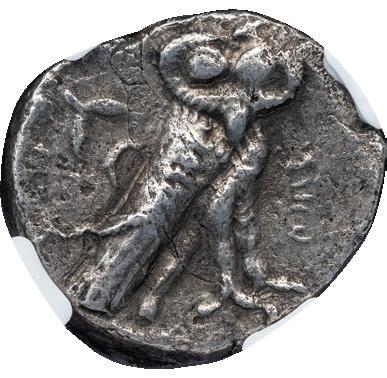
Obv. Helmeted head of Athena right. Rev. MZDK (Aramaic), owl standing right, head facing, olive sprig and crescent in left field. Van Alfen, “The Owls from the 1979 Iraq Hoard,” AJN 12 (2000), Group V.
NGC graded CHOICE XF, Strike 5/5, Surface 2/5, scarce issue of particularly fine style for the series, and a specimen that it lacks any test cuts that are frequently found on these coins. $ 1250
After the Macedonian conquest of the Persian Empire, Alexander the Great often retained Persians as local satraps on the assumption that they would know best how to govern the indigenous non–Greek populations and make Macedonian rule more palatable. The Persian Mazaces was one such individual. He had had the misfortune of being appointed satrap of Egypt just after the Battle of Issus (333 BC) and only remained at this post until the arrival of Alexander in the following year. Mazaces is thought to have offered his submission to the conquering Macedonian king who then appointed him to govern the satrapy of Mesopotamia. Coins such as this, which imitate the Athenian tetradrachm but name Mazaces in Aramaic script, were probably struck in order to pay mercenaries of non–Greek origin and who were long accustomed to the types of the famous Athenian tetradrachm.
16
ARMENIAN
A RARE
DOUBLE STRUCK TETRADRACHM
BYZANTIUM AND ITS GOLD COINAGE

In 498, Anastasius I reformed the heavily debased and failing bimetallic currency system inherited from the late Roman Empire, to create a system that hinged on the gold solidus and its fractions and was supported by a new large–module bronze coinage denominated as multiples of the tiny late Roman nummus. Silver coins were still produced occasionally, but they ceased to be an important part of the monetary system.
Anastasius’ reform provided a stable basis for Byzantine coinage for over 500 years. It was not until the 1030s that the solidus, which was also known as the histamenon nomisma, began to suffer debasement. By the early reign of Alexius I (1081–1118), the denomination had lost considerable weight and contained so little gold that it was abandoned and replaced by the characteristically scyphate gold hyperpyron. The new electrum aspron trachy, worth about a third of the hyperpyron, was also introduced alongside the billon stamenon and bronze tetarteron and noummion. The hyperpyron remained the standard Byzantine gold denomination into the 1350s, but began to be overshadowed by the silver basilikon, a coin imitating the influential Venetian ducat, in the reign of Andronicus II (1282–1328). By the end of the 14th century, Byzantine coinage had become a mere shadow of its former self and largely disappeared in the flood of Italian gold and silver coins brought into the dwindling Byzantine territories by Venetians and other traders.
Although the Byzantine Empire had grown out of the old Roman Empire—originally a pagan enterprise—the Byzantine Empire was thoroughly Christian and over time this was increasingly emphasized on the coinage. The winged figure who appears on solidi and fractions struck in the period from Justin I (518–527) to Phocas (602–610) could be read variously as Victory (mentioned in the surrounding legends) or as a Christian angel. From Heraclius (610–641) to Tiberius III (698–705) gold reverses were dominated by depictions of crosses, often atop three steps. Under Justinian II (705–711) the bust of Christ Pantocrator was first introduced as a Byzantine coin type, while his enthroned figure and the bust of the Virgin Mary first appear under Basil I (867–886) and Leo VI (886–912), respectively. Henceforth, images of Christ and the Virgin, sometimes shown crowning the emperor, became standard types. They were joined by lesser Christian figures, including St. Michael the Archangel, St. Demetrius, and St. Constantine the Great beginning in the 11th century, and continued even during the period of the Latin occupation of Constantinople and the Byzantine rump states (1204–1261).
THE FIRST BYZANTINE EMPEROR



19576. BYZANTINE EMPIRE. ANASTASIUS I, AD 491–518. Gold Solidus, 4.46 g, 21 mm. Issue of Constantinople, officina I. Obv. D N ANASTASIVS P P AVG, three quarters facing bust of Anastasius, wearing cuirass and holding spear and shield with horseman device. Rev. VICTORIA AVGGG I, Victory standing left, holding long jeweled cross, star in right field, CONOB in exergue. Sear 3.
NGC graded MINT STATE, Strike 5/5, Surface 4/5. $ 1950
Numismatists consider Anastasius to be the “first” Byzantine emperor by virtue of his having established new and complex monetary reforms that created Byzantine coinage. David Sear begins the listings in his book Byzantine Coins and their Values with his reign.
17
The figure of Victory, represented as a winged woman, was a staple of Roman coinage for centuries. A statue of the goddess stood in the Roman senate house and it was said that as long as she remained there the Roman empire would never fall. When Christianity became the dominant religion of the empire, images of Victory were regarded as “pagan” and inappropriate.
Thus, under the second Byzantine emperor, Justin I, a major shift occurred on coinage, removing the goddess from the most important denomination produced by the mint, the solidus. The goddess was replaced by a Christian counterpart, an angel, a new type of winged figure, standing and fully frontal, looking straight out towards the viewer, wearing a closely cropped hairdo and holding a cross and a cross-topped orb (the so-called “globus cruciger”). The legend proclaims – as before – “VICTORIA AVG,” but visually the figure bears only a superficial resemblance to Victoria. Generally shown as puppet-like, somewhat androgynous and with a schematic cartoon-like face, Justin’s winged beings are undoubtedly meant to be angels, as they resemble what are clearly angels in other works of art, including an ivory diptych now in the British Museum (which is slightly later, possibly dating to the reign of Justinian). It may well be that the new figure provided an easy transition from the well-established tradition of pagan winged figures into a more politically correct world of Christian beings. Although Justin’s angel is genderless, it is winged, it holds many of the attributes that were also held by Victoria, and it still is labeled “VICTORIA AVGVSTI” in the coin’s legend. It thus becomes a type of polyvalent image, one that could be interpreted in different ways, depending on the inclinations of each viewer. Ultimately, this was a very effective solution for coins, a medium that had to appeal to all in order to function properly.

19503. BYZANTINE EMPIRE. JUSTIN I, AD 518–527.
Gold Solidus, 4.09 g, 21 mm. Issue of Constantinople officina I, AD 518-519.
Obv. DN IVSTINVS P P AVC, helmeted and cuirassed bust of Justin slightly right, holding spear and shield with horseman device. Rev. VICTORIA AVCCC I, Victory standing left, holding staff with staurogram, star in left field, CONOB in exergue. Sear 55.
NGC graded CHOICE AU, Strike 5/5, Surface 3/5, “clipped.”

19441. BYZANTINE EMPIRE. JUSTIN I, AD 518–527.
Gold Solidus, 4.32 g, 20 mm. Issue of Constantinople, officina S, AD 522–527.
$ 1750
Obv. D N IVSTINVS P P AVC, helmeted and cuirassed bust of Justin slightly right, holding spear and shield with horseman device. Rev. VICTORIA AVCCC S, Angel standing, facing, holding long cross and globus cruciger, star at right, CONOB in exergue. Sear 56.
NGC graded MINT STATE, Strike 5/5, Surface 2/5, “clipped.” $ 1750

17835. BYZANTINE EMPIRE. JUSTIN I, AD 518-527.
Gold Solidus, 4.47 g, 21 mm. Issue of Constantinople, officina Δ, AD 522-527.
Obv. D N IVSTINVS P P AVC, helmeted and cuirassed bust of Justin slightly right, holding spear and shield with horseman device. Rev. VICTORIA AVCCC Δ, angel standing, facing, holding globus cruciger and long cross, star at right, CONOB in exergue. Sear 56.
NGC graded MINT STATE, Strike 5/5, Surface 5/5. $ 2650
18
FROM VICTORY TO ANGEL






19
JUSTINIAN’S ISSUES OF ROME
The rare gold solidi of Justinian I from the mint of Rome were primarily struck to support the efforts of the general Belisarius to recapture and hold onto the Eternal City, which had not seen the rule of an emperor in the 60 years since the last Western Roman emperor, Romulus Augustus, was deposed by the Germanic king Odoacer in AD 476. As part of a larger war to reclaim Italy for Justinian, Belisarius recaptured Rome in AD 536. The city was quickly, but unsuccessfully, besieged by the Ostrogothic king Vitiges in 537–538, but his successor, Totila, took and sacked Rome in AD 546 after a terrible siege in which the Romans were reduced to extreme hunger. Belisarius returned to retake Rome in AD 547, hastily trying to shore up the city’s defenses by filling holes in the walls with loose stones, but to little purpose. Totila captured Rome again in AD 549 and plundered what little else he had missed when he sacked it the first time. Although they were intended to pay soldiers and to cover the other expenses of defending the city, solidi like the present pieces are also likely to have been carried off by Totila and the Ostrogoths following their second sack of Rome since the coins are believed to have been struck during Belisarius’ brief return to Rome in AD 547–549.

19579. BYZANTINE EMPIRE. JUSTINIAN I, AD 527–565.
Gold Solidus, 4.43 g, 21 mm. Issue of Rome, officina Λ, ca. AD 547–549.
Obv. D N IVSTINIANVS P P AVC, helmeted and cuirassed bust of Justinian I, facing, holding globus cruciger and shield with horseman device. Rev. VICTORIA AVCCC Λ, angel standing, facing, holding globus cruciger and long cross, star at right, CONOB in exergue. Sear 289 corr.
Ex Künker 182, 3/14/ 2011, lot 1018.
NGC graded CHOICE AU, Strike 4/5, Surface 2/5, “brushed,” “slight bend,” rare emission with only 8 others on CoinArchives. Although Sear records only officina A, it is likely he confused the tiny letter with a Λ, the officina that appears on most specimens in the market and is crystal clear on this specimen. $ 1750

19581. BYZANTINE EMPIRE. JUSTINIAN I, AD 527–565.
Gold Solidus, 4.37 g, 20 mm. Issue of Rome, officina Δ, ca. AD 547–549.
Obv. D N IVSTINIANVS P P AVC, helmeted and cuirassed bust of Justinian I, facing, holding globus cruciger and shield with horseman device. Rev. VICTORIA AVCCC Δ, angel standing, facing, holding globus cruciger and staff with staurogram, star at right, CONOB in exergue.
Sear 291.
Ex Veilinghuis Eeckhout 5, 11/13/2010, lot 126.
NGC graded AU, Strike 5/5, Surface 4/5, “clipped,” officina Δ is rarely encountered.
JUSTINIAN I ISSUE FROM ROME WITH RECUT OFFICINA

19580. BYZANTINE EMPIRE. JUSTINIAN I, AD 527–565.
Gold Solidus, 4.46 g, 21 mm. Issue of Rome, officina S recut over Θ, ca. AD 547–549.
$ 2200
Obv. D N IVSTINIANVS P P AVC, helmeted and cuirassed bust of Justinian I, facing, holding globus cruciger and shield with horseman device. Rev. VICTORIA AVCCC S/Θ, angel standing, facing, holding globus cruciger and staff with staurogram, star at right, CONOB in exergue.
Sear 291.
Ex CNG Electronic Auction 285, 8/22/2012, lot 395.
NGC graded MINT STATE, Strike 5/5, Surface 4/5, with recut officina (S over Θ) and an exergue legend variety seemingly reading CONOR, a very rare coin in an exceptional state of preservation. $ 2750
20






21


19577. BYZANTINE EMPIRE. JUSTINIAN I, AD 527–565 AD.
Gold Semissis, 2.22 g, 18 mm. Issue of Constantinople.

Obv. D N IVSTINI–ANVS P P AVC, diademed, draped, and cuirassed bust of Justinian I right. Rev. VICTORIA AVCCC, Victory seated right, inscribing shield, star in left field, staurogram in right field, CONOB in exergue. Sear 144.
NGC graded MINT STATE, Strike 4/5, Surface 3/5, “scratches,” “clipped,” “struck–in fold–over,” an extremely rare ancient error coin. $ 950
In modern times with machine-produced coinage this highly unusual error occurs when a planchet is caught vertically (rather than being flat) between the dies at the time of striking, creating a partial section folded over at the edge. With hand-produced coinage, it’s difficult to see how the prominent flap could have occurred, but likely the planchet was originally extremely elongated and subsequently restruck with a folded over section fully integrated into the new coin. On this type of error see: https://www.error-ref.com/fold_over_stk_inward/.


19583. BYZANTINE EMPIRE. JUSTIN II, AD 565–578.
Gold Solidus, 4.41 g, 21 mm. Issue of Thessalonica, ca. AD 570.

Obv. D N IVSTINVS P P AVI, facing bust of Justin II holding Victory on globe. Rev. VICTORIA AVCCC, Constantinopolis seated, looking right, holding scepter and globus cruciger, CONOB in exergue. Sear 364d.
Ex CNG 93, 5/22/2013, lot 1317.
NGC graded MINT STATE, Strike 5/5, Surface 4/5, lustrous, and beautifully centered, an exceptional specimen for this scarce emission. $ 1900


19582. BYZANTINE EMPIRE. JUSTIN II, AD 565–578.

Gold Solidus of 22 siliqua weight, 4.01 g, 20 mm. Issue of Antioch (or possibly Constantinople).
Obv. D N IVSTINVS PP AVI, facing bust of Justin II holding Victory who crowns him. Rev. VICTORIA AVCCC ΘS, Constantinopolis seated, facing, looking right, holding scepter and globus, OB *+* in exergue. Sear 376 (as Theoupolis, Antioch).
NGC graded CHOICE AU, Strike 5/5, Surface 2/5, “edge bend,” “clipped” noted. Sear attributes these to Antioch, but notes that they have been placed at Constantinople by Hahn. $ 875
22
RARE STRUCK-IN FOLD-OVER ERROR
A


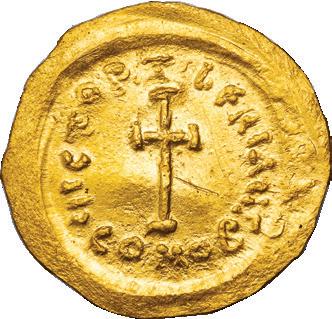
19508. BYZANTINE EMPIRE. TIBERIUS II CONSTANTINE, AD 578–582.
Gold Tremissis, 1.50 g, 17 mm. Issue of Constantinople.
Obv. D M COSTANTINVS PP AC, diademed, draped, and cuirassed bust of Tiberius II right. Rev. ЧICTOR TIbЄRI AЧS, cross potent, CONOB in exergue. Sear 425.
NGC graded CHOICE AU, Strike 5/5, Surface 3/5, “edge bend,” “marks.” $ 875


19586. BYZANTINE EMPIRE. PHOCAS, AD 602–610.

Gold Solidus, 4.48 g, 21 mm. Issue of Constantinople, officina H. Obv. D N FOCAS PЄRP AVC, crowned, draped, and cuirassed bust of Phocas, facing, holding globus cruciger. Rev. VICTORIA AVϚЧ H, angel standing, facing, holding staff with staurogram and globus cruciger, CONOB in exergue. Sear 620.
Ex Numismatica Ars Classica 56, 10/8/2010, lot 605.
NGC graded MINT STATE, Strike 5/5, Surface 3/5, “brushed.”
A ROTATED DOUBLE-STRIKE SEMISSIS



$ 1150
19588. BYZANTINE EMPIRE. PHOCAS, AD 602–610. Gold Semissis, 1.90 g, 19 mm. Issue of Constantinople. Obv. d N FOCAS–PЄR AVG, diademed, draped, and cuirassed bust of Phocas right. Rev. VICTORIA AVϚЧ, Victoria striding right, head left, holding wreath and globus cruciger, CONOB in exergue. Sear 631.
NGC graded CHOICE AU, Strike 2/5, Surface 2/5, “bent,” “double–struck,” “clipped.” An impressive double strike with slight rotation, visible primarily on the reverse where the left part of the coin is doubled and shifted slightly upward. $ 650
23
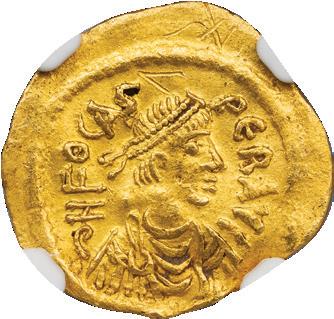


19589. BYZANTINE EMPIRE. PHOCAS, AD 602–610.
Gold Tremissis, 1.48 g, 17 mm. Issue of Constantinople.
Obv. d N FOCAS PЄR AVC, diademed, draped, and cuirassed bust of Phocas right. Rev. VICTORI FOCAS AVϚ, cross potent, CONOB in exergue.
Sear 634.
NGC graded CHOICE XF, Strike 5/5, Surface 2/5, “wrinkled,” “graffiti.”



19506. BYZANTINE EMPIRE. HERACLIUS, AD 610–641.
Gold Semissis, 2.19 g, 19 mm. Issue of Constantinople, officina I, ca. AD 610–613.
$ 450
Obv. d N hRACLIЧS P P AVC I, diademed, draped, and cuirassed bust of Heraclius right. Rev. VICTORIA AVϚЧ, cross potent on globe. Sear 784.
NGC graded MINT STATE, Strike 5/5, Surface 3/5, “bent,” “brushed,” “clipped,” nicely centered on broad planchet with exceptional detail. $ 950
A REMARKABLE FLIPPED-OVER DOUBLE STRUCK TREMISSIS



19560. BYZANTINE EMPIRE. HERACLIUS, AD 610–641.
Gold Tremissis, 1.49 g, 17 mm. Issue of Constantinople, ca. AD 610–613.

Obv. d N hRACLIЧS PP AVC, diademed, draped, and cuirassed bust of Heraclius right. Rev. VICTORIA AVϚЧ, cross potent, CONOB in exergue.
Sear 786.
Near mint state, crimped, scratched, graffito, an interesting flipped–over double strike error.
$ 475
24
A FLIPPED–OVER DOUBLE STRUCK SOLIDUS



19591. BYZANTINE EMPIRE. HERACLIUS WITH HERACLIUS CONSTANTINE, AD 610–641.
Gold Solidus, 4.44 g, 22 mm. Issue of Constantinople, officina Δ.
Obv. dd NN hЄRACLIЧS ЄT hЄRA CONST P P AV Ч, facing busts of Heraclius (left) and Heraclius Constantine (right), cross above. Rev. VICTORIA AVϚЧ Є, cross potent on stepped base, CONOB in exergue. Sear 738.
NGC graded MINT STATE, Strike 2/5, Surface 3/5, “clipped,” “flipped–over double strike,” the doubled impression showing the right side of Heraclius appears on the reverse underneath the final strike. $ 1400



19592. BYZANTINE EMPIRE. HERACLIUS WITH HERACLIUS CONSTANTINE, AD 610–641.
Gold Solidus, 4.43 g, 21 mm. Issue of “uncertain eastern mint,” officina I.
Obv. dd NN hЄRACLIЧS ЄT hЄRA CONST, facing draped busts of Heraclius (left) and Heraclius Constantine (right), cross above. Rev. VICTORIA AVϚЧ I, cross potent on stepped base, CONOB in exergue. Sear 851.
NGC graded CHOICE AU, Strike 5/5 Surface 2/5, “wrinkled,” “scuff,” an emission that has been variously attributed to Jerusalem, Alexandria and Cyprus. $ 875
IMPRESSIVE DOUBLE-STRIKE


19494. BYZANTINE EMPIRE. CONSTANTINE IV, AD 668–685.
Gold Solidus, 4.33 g, 21 mm. Issue of Constantinople, uncertain officina.

Obv. D N CONЧS P P, helmeted (with crest and plume) and cuirassed bust facing slightly right, holding spear and shield with horseman device.
Rev. VICTOA–AVςЧ ?, Heraclius and Tiberius with cross potent between them, CONOB in exergue. Sear 1156.
NGC graded CHOICE AU, Strike 2/5, Surface 2/5, “die shift,” “clipped,” graffito,” lustrous, a truly impressive double strike, duplicating a substantial part of the devices on both sides of the coin. $ 850
25



19594. BYZANTINE EMPIRE. CONSTANS II, AD 641–688.
Gold Solidus, 4.47 g, 20 mm. Issue of Constantinople officina B, ca. AD 649/50–651/2.
Obv. d N CONStAN–tINЧS P P AV, crowned and draped bust of Constans II, facing, holding globus cruciger. Rev. VICTORIA–AVϚЧ B, cross potent on three–stepped base, CONOB below. Sear 956.
NGC graded as CHOICE AU, Strike 5/5, Surface 3/5, “brushed.”



19596. BYZANTINE EMPIRE. CONSTANS II, AD 641–668.
Gold Solidus, 4.46 g, 11 mm. Issue of Carthage, Indictional year 2, AD 643/4.
$ 1100
Obv. D N CONSTANTINV P P, crowned and draped bust of Constans II, facing, holding globus cruciger. Rev. VICTORIAϚЧ Δ B, cross potent on three–stepped base, CONOB below. Sear 1029.
NGC graded CHOICE XF, Strike 5/5, Surface 4/5.



19595. BYZANTINE EMPIRE. CONSTANS II WITH CONSTANTINE IV, AD 654–688. Gold Solidus, 4.36 g, 19 mm. Issue of Constantinople, officina Δ, AD 654–668.
$ 950
Obv. CONSTANTINЧS C CONSTANTINI, crowned and draped busts of Constans and Constantine, facing, cross above. Rev. VICTORIA–AVϚЧ Δ, cross potent on three-stepped base, CONOB below. Sear 959.
NGC graded MINT STATE, Strike 4/5, Surface 4/5, “clipped.”
$ 1150
26



19597. BYZANTINE EMPIRE. CONSTANS II WITH CONSTANTINE IV, AD 654–688.
Gold Solidus, 4.51 g, 11 mm. Issue of Carthage, AD 654–668.
Obv. Crowned and draped busts of a bearded Constans II (left) and Constantine IV (right), facing. Rev. Crowned and draped busts of Heraclius (left) and Tiberius (right), facing, cross potent on stepped base between them. Sear 1044.
NGC graded CHOICE XF, Strike 4/5, Surface 4/5, a particularly rare issue with some 15 specimens in market records. $ 1250


19500. BYZANTINE EMPIRE. JUSTINIAN II, FIRST REIGN, AD 685–695.

Gold Solidus, 4.47 g, 20 mm. Issue of Constantinople, perhaps officina Z, ca. AD 685–695. Obv. IhS CRISTOS RЄX REgNANTIЧM, bust of bearded Christ Pantocrator, facing, holding Gospels and raising his right hand in benediction. Rev. D IЧSTIN[IA]NЧS SЄRЧ ChRISTI Z(?), Justinian standing, facing, wearing loros and holding cross potent on a two–stepped base, [CONOP] in exergue. Sear 1248.
NGC graded MINT STATE, Strike 3/5, Surface 4/5. $ 5200
The introduction of Jesus Christ on Byzantine coinage takes place with this issue minted under Justinian II, whose rule is separated into two distinct periods, before and after his exile from Constantinople. During Justinian’s “First Reign” Christ appears for the first time on coinage, shown bearded and with the traits of a classical philosopher, accompanied by the legend “Rex Regnantium” (“King of Kings”). The great French numismatist Lacam has referred to this portrait type as the “Christ of the Ascension and Redemption.”

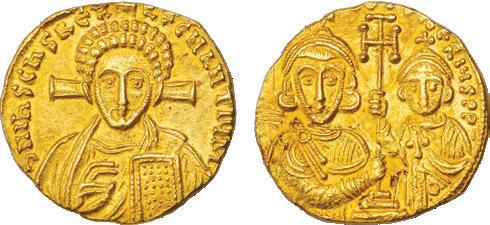

19495. BYZANTINE EMPIRE. JUSTINIAN II, SECOND REIGN, AD 705–711. Gold Solidus, 4.31 g, 19 mm. Issue of Constantinople. Obv. ꝹN IhS ChS RЄX RЄGNANTIЧM, bust of youthful Christ Pantocrator, facing, holding Gospels and raising his right hand in benediction. Rev. ꝹN IЧSTINIANЧS ЄT TIbЄRIЧS PP A, facing half–length busts of Justinian II and Tiberius, both holding a central cross potent with stepped base. Sear 1414.
NGC graded CHOICE AU, Strike 4/5, Surface 2/5, “clipped,” “scratches,” with well centered and dignified Christ. $ 3700
During his return to power following his exile (the “Second Reign”), Justinian II adopted an entirely new image of Christ for his coinage, a youthful portrait with eastern features, including curly short–cropped hair and a kind, welcoming expression. It is an image likely based on the iconographical traditions of Christian Syria and some have observed that it may be based on an icon of the “historical” Christ as he appeared before the Crucifixion.
27


19599. BYZANTINE EMPIRE. CONSTANTINE VIII, AD 1025-1028.

Gold Histamenon Nomisma, 4.36 g, 24 mm. Issue of Constantinople. Obv. +IhS XIS RЄX RЄGNANTIЧM, bust of bearded Christ Pantocrator, facing, holding Gospels and raising his right hand in benediction. Rev. +CωNSτANτIN bASILЄЧS ROm, bearded bust of Constantine VIII, facing, holding labarum and akakia. Sear 1815.
NGC graded AU, Strike 5/5, Surface 3/5, “clipped.”


19524. BYZANTINE EMPIRE. ROMANUS III, AD 1028–1034.
Gold Histamenon Nomisma, 4.41 g, 25 mm. Issue of Constantinople.
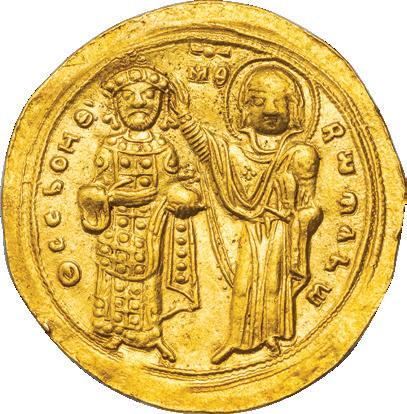
$ 1950
Obv. +IhS XIS RЄX RЄGNANTIЧM, Christ enthroned, facing, holding Gospels and raising his right hand in benediction. Rev. ΘCE ΒΟΗΘ ΡωΜΑΝω, Virgin standing on right, facing, crowning Romanus on left, Μ–Θ above. Sear 1819.
NGC graded CHOICE XF, Strike 5/5, Surface 4/5, perfect centering and struck on a medallic planchet.


19600. BYZANTINE EMPIRE. CONSTANTINE IX, AD 1042–1055.

$ 1650
Gold Histamenon Nomisma (scyphate), 4.39 g, 28 mm. Issue of Constantinople. Obv. IhS XIS RЄX RЄGNANTIЧM, Christ enthroned, facing, holding Gospels and raising his right hand in benediction. Rev. +CωhSτAhτh bASILЄЧ RM, bearded bust of Constantine IX, holding cross staff with tendril ornaments and globus cruciger Sear 1828.
NGC graded CHOICE XF, Strike 5/5, Surface 3/5, “slight bend,” perfectly centered on a medallic planchet.
$ 1500
28



19601. BYZANTINE EMPIRE. CONSTANTINE IX, AD 1042–1055.
Gold Tetarteron Nomisma, 4.07 g, 18 mm. Issue of Constantinople.
Obv. IhS XIS RЄX RЄGNANTIhM, bust of Christ Pantocrator, facing, holding Gospels and raising his right hand in benediction. Rev. +CωNSτANτNOS LE RM, crowned bearded bust of the emperor, holding labarum and globus cruciger. Sear 1833.
Ex Spink & Son, privately sold, with tag.
NGC graded CHOICE AU, Strike 5/5, Surface 3/5, “brushed,” bold Christ portrait. $ 1950


19603. BYZANTINE EMPIRE. CONSTANTINE X, AD 1059–1067.

Gold Histamenon Nomisma (scyphate), 4.40 g, 26 mm. Issue of Constantinople. Obv. +IhS XIS RЄX RЄGNANTIЧM, Christ enthroned, facing, holding the Gospels. Rev. +KωN RAC Λ O ΔOVKAC, Constantine, standing, holding globus cruciger and labarum with pellet on the shaft. Sear 1847.
NGC graded CHOICE XF, Strike 5/5, Surface 3/5.
$ 950

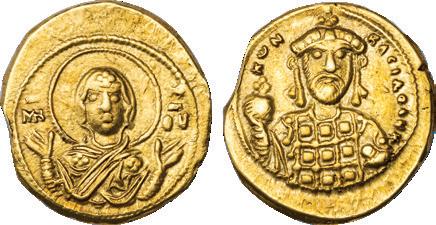
19453. BYZANTINE EMPIRE. CONSTANTINE X, AD 1059–1067.

Gold Tetarteron Nomisma, 3.96 g, 19 mm. Issue of Constantinople. Obv. Half bust of the Virgin orans, facing, MHP–ΘV (Mother of God) and pellets above, all in fields. Rev. +KωN RACΔ O ΔVK, crowned bust of Constantine X, facing, holding globus cruciger and akakia. Sear 1849.
NGC graded XF, Strike 5/5, Surface 2/5, “edge filing.”
$ 1950
29

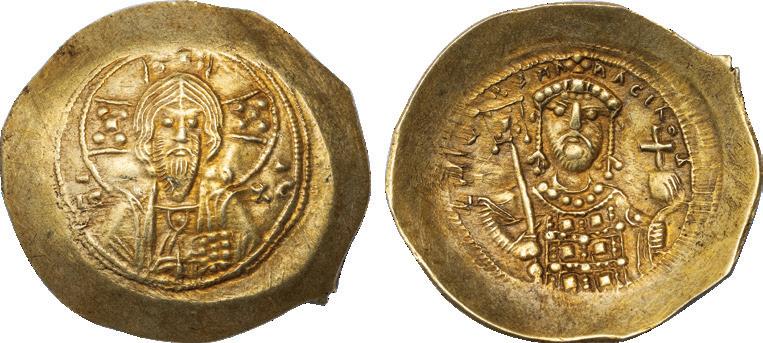
19487. BYZANTINE EMPIRE. MICHAEL VII, AD 1071–1078.

Gold/electrum Histamenon Nomisma (scyphate), 4.40 g, 29 mm. Issue of Constantinople. Obv. IC–XC, bust of Christ Pantocrator, facing, holding the Gospels and raising his right hand in benediction, IC–XC in fields. Rev. + MIXAHΛ RACIΛE, bust of Michael VII, facing, wearing loros, holding labarum and globus cruciger. Sear 1868.
NGC graded AU, Strike 4/5, Surface 3/5.


19516. BYZANTINE EMPIRE. MANUEL I, AD 1143–1180.
Gold Hyperpyron (scyphate), 4.20 g, 31 mm. Issue of Constantinople.

$ 850
Obv. +KE ROHΘEI, bust of youthful Christ Emmanuel, beardless, facing, holding scroll and raising his right hand in benediction, IC–XC flanking him. Rev. MANOVHΛ ΔECΠOTH –TѠ ΠOPΦVPΓЄNTѠ, Manuel standing, facing, holding labarum and globus cruciger, hand of God (manus Dei) blessing him from above. Sear 1956.
NGC graded AU, Strike 4/5, Surface 2/5, “wavy flan,” “graffito.” $ 1250


19375. BYZANTINE EMPIRE. MANUEL I, AD 1143–1180.
Electrum Aspron Trachy (scyphate), 3.97 g, 34 mm. Issue of Constantinople.

Obv. Christ enthroned, facing, holding Gospels and raising his right hand in benediction, IC–XC in field. Rev. [MANUHΛ ΔЄCΠOTH], Manuel on left holding akakia, and the Virgin on right, both holding patriarchal cross between them, M–ΘV around Virgin’s head. Sear 1958.
Ex Bob Guynn Collection.
NGC graded CHOICE AU, Strike 4/5, Surface 3/5, “edge crimps,” a well struck specimen of this scarce issue with exceptionally struck full faces. $ 1850
30


18901. BYZANTINE EMPIRE. ISAAC II, AD 1185–1195.
Electrum Aspron Trachy (scyphate), 3.99 g, 30 mm. Issue of Constantinople.

Obv. Virgin enthroned, holding bust of infant Christ, MP–ΘV (mother of God) in fields. Rev. ICAAKIOC Δ, archangel Michael, standing, crowning emperor, Θ between their heads, X/M in lower right field. Sear 2002.
NGC graded CHOICE AU, Strike 5/5, Surface 4/5, with a sensitive depiction of the Virgin.
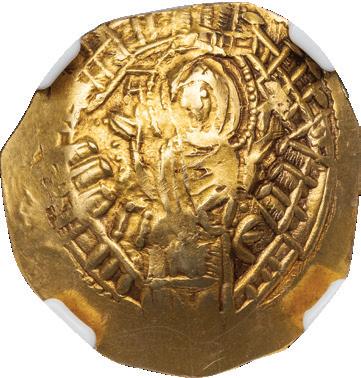

19606. BYZANTINE EMPIRE. MICHAEL VIII, AD 1261–1282.

950
Gold/electrum Hyperpyron (scyphate), 4.13 g, 22 mm. Issue of Constantinople, sigla Π Є. Obv. MP–ΘV, Virgin orans standing within the city walls of Constantinople, Π | Є (sigla). Rev. XMΛITI–M, Christ holding Gospels on right, Archangel Michael above kneeling emperor on left, Π/Π/Є (sigla) in center. Sear 2243.
Ex Heritage 3045, 1/12/2016, lot 32475.
NGC graded MINT STATE, Strike 4/5, Surface 5/5, among the 7 currently highest graded specimens in the NGC census (6 MS, 1 MS STAR). $ 2750
The return of Constantinople to Byzantine imperial control after the reconquest from the Latin forces of the Fourth Crusade was a cause of great celebration and inspired an important modification to the traditional depiction of the Virgin on coins. Gold issues struck from the time of Michael VIII to the joint reign of Andronicus II with Andronicus III (AD 1325–1334) depict her within the turreted walls of Constantinople as an image of thanksgivingg as well as hope for her future protection. Alas, her protection was not for all time. In AD 1453, Constantinople fell to Mehmed II and the Ottoman Turks, thereby ending the thousand-year history of the Byzantine Empire and its coinage.


19607. BYZANTINE EMPIRE. ANDRONICUS II & MICHAEL IX, AD 1294–1320. Gold/electrum Hyperpyron (scyphate), 3.97, 23 mm. Issue of Constantinople.

Obv. Virgin orans standing within the city walls of Constantinople. Rev. Christ standing, facing, blessing the two emperors kneeling on either side.
Sear 2396.
NGC graded CHOICE VF, Strike 3/5, Surface 4/5. $ 575
31
$



















































































































































































































